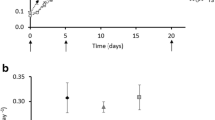Abstract
Toxicological responses of the filamentous N2-fixing cyanobacteriumNostoc calcicola Bréb. towards Hg2+ were studied to enumerate the decisive lethal events. In low-dose, long-term experiments (0.05–0.25 μm Hg2+, 10 days), photoautotrophic growth was severely inhibited with concurrent loss of photosynthetic pigments (phycocyanin>chlorophyll α>carotenoids) and nucleic acids. The termination of growth after a day 4 exposure to 0.25 μm Hg2+ has been attributed to the complete inhibition ofin vivo photosynthetic activity in the cyanobacterium (O2 evolution>14CO2 incorporation). The elevated Hg2+ concentrations irreversibly damaged the cell membrance as observed under light microscopy, and as indicated by the leakage of intracellular electrolytes and phycocyanin. In high-dose, short-term experiments (0.5–20.0 μm Hg2+, up to 6 h), thein vivo activities of selected enzymes (glutamine synthetase > nitrate reductase > nitrogenase) were less inhibited by Hg2+ than the uptake of nutrient ions (NH +4 >NO −3 >PO 3−4 ).
Similar content being viewed by others
References
Allen MB, Arnon DI. 1955 Studies on nitrogen-fixing blue-green algae. I. Growth and nitrogen fixation byAnabaena cylindrica Lemm.Plant Physiol 30, 366–372.
Allen MM. 1968 Photosynthetic membrane system inAnacystis nidulans.J Bacteriol 96, 836–841.
APHA. 1989 Phosphate: stannous chloride method. In: Clesceri LC, Greenberg AE, Trussell RR, Franson MAH, eds..Standard Methods for the Examination of Water and Wasterwater, 17th edn. Washington, DC: American Public Health Association; 4.175–4.176.
Asthana RK, Pandey PK, Singh SP. 1990 Nickel regulation of photoautotrophy in a cyanobacterium.Water Air Soil Pollut 52, 263–276.
Brody SS, Brody M. 1961 A quantitative assay for the number of chromophores on a chromoprotein: its application to phycoerhthrin and phycocyanin.Biochim Biophys Acta 50, 348–352.
Burris RH, Wilson PW. 1957 Methods for measurement of nitrogen Fixation.Methods Enzymol 4, 355–366.
Duxbury T. 1985 Ecological aspects of heavy metal responses in microorganisms.Microb Ecol 8, 185–235.
Herbert D, Phipps PJ, Strange RE. 1971 Chemical analysis of microbial cells.Methods Microbiol VB, 209–344.
Jeffries TW. 1982 The microbiology of mercury.Progr Indust Microbiol 76, 21–75.
Knowles SC, Zingmark RG. 1978 Mercury and temperature interactions on the growth rates of three species of freshwater phytoplankton.J Phycol 14, 104–109.
Kratz WA, Myers J. 1955 Nutrition and growth of several blue-green algae.Am J Bot 42, 282–287.
Leonard A, Jacquet P, Lauwerys RR. 1983 Mutagenecity and teratogenecity of mercury compounds.Mutat Res 114, 1–18.
Lowry OH, Rosebrough NJ, Farr AL, Randall RJ 1951 Protein measurements with the Folin phenol reagent.J Biol Chem 193, 265–273.
Murthy SDS, Bukhov NG, Mohanty P. 1990 Mercury-induced alterations of chlorophylla fluorescence kinetics in cyanobacteria.J Photochem Photobiol 6, 373–380.
Murthy SDS, Sabat SC, Mohanty P. 1989 Mercury-induced inhibition of photosystem II activity and changes in the emission of fluorescence fromSpirulina platensis.Plant Cell Physiol 30, 1153–1157.
Myers J, Kratz WA. 1955 Relationship between pigment content and photosynthetic characteristics in a blue-green alga.J Gen Physiol 39 11–21.
Nicholas DJ, Nason A. 1957 Determination of nitrate and nitrite.Methods Enzymol III, 981–984.
Nuzzi R. 1972 Toxicity of mercury to phytoplankton.Nature 237, 38–40.
Pandey PK, Singh CB, Singh SP. 1992 Cu uptake in a cyanobacterium: characterization of selected photochemical reactions.Curr Microbiol 24, 35–39.
Rachlin JW, Jensen TE, Baxter M, Jani V. 1982 Utilization of morphometric analysis in evaluating response ofPlectonema boryanum (Cyanophyceae) to exposure to eight heavy metals.Arch Environ Contam Toxicol 11, 323–333.
Rai LC, Gaur JP, Kumar HD. 1981 Phycology and heavy metal pollution.Biol Rev 56, 99–151.
Ramamoorthy S, Cheng TC, Kushner DJ. 1982 Effect of microbial life stages on the fate of methylmercury in natural waters.Bull Environ Contam Toxicol 29, 167–173.
Ramelow GJ, Maples RS, Tumpson RL, et al. 1987 Periphyton as monitors of heavy metal pollution in Calcasieu river estuary.Environ Pollut 43, 247–261.
Shapiro BM, Stadtman ER 1970 Glutamine synthetase (Escherichia coli).Methods Enzymol 17A, 910–922.
Shieh YJ, Barber J. 1973 Uptake of mercury byChlorella and its effect on potassium regulation.Planta 109, 49–60.
Simkiss K. 1979 Metal ions in cells.Endeavour 3, 2–6.
Singh CB, Singh SP. 1987 Effect of mercury on photosynthesis inNostoc calcicola: role of ATP and interacting heavy metal ions.J Plant Physiol 129, 49–58.
Singh CB, Singh SP. 1990 Hg2+-induced leakage of electrolytes and inhibition of NO −3 utilization inNostoc calcicola: role of interacting cations.Biol Metals 3, 208–212.
Singh CB, Singh SP. 1992 Protective effects of Ca2+, Mg2+, Cu2+ and Ni2+ on mercury and methylmercury toxicity to a cyanobacterium.Ecotoxicol Environ Safety 23, 1–10.
Singh CB, Verma SK, Singh SP (1987) Impact of heavy metals on glutamine synthetase and nitrogenase activity inNostoc calcicola.J Gen Appl Microbiol 33, 87–91.
Singh DP, Khare P, Bisen PS. 1989 Effect of Ni2+, Hg2+ and Cu2+ on growth, oxygen evolution and photosynthetic electron transport inCylindrospermum PU 942.J Plant Physiol 134, 406–412.
Singh SP, Verma SK, Singh RK, Pandey PK. 1989 Copper uptake by a free and immbolized cyanobacterium.FEMS Microbiol Lett 60, 193–196.
Singh SP, Yadava V. 1983 Cadmium induced inhibition of nitrate uptake inAnacystis nidulans: interaction with other divalent cations.J Gen Appl Microbiol 29, 297–304.
Singh SP, Yadava V. 1984 Cadmium induced inhibition of ammonium and phosphate uptake inAnacystis nidulans: interaction with other divalent cations.J Gen Appl Microbiol 30, 79–86.
Snell FD, Snell CT. 1949 Nitrate. In: Snell FD Snell CT, eds.Colorimetric Methods of Analysis. 3rd edn, Vol. II. New York: D. Van Nostrand; 785–807.
Sorentino C. 1979 The effect of heavy metals on phytoplankton—a review.Phykos 18, 149–161.
Stewart WDP, Fitzgerald GP, Burris RH. 1968 Acetylene reduction by nitrogen-fixing blue-green algae.Arch Microbiol 62, 336–348.
Stratton GW, Huber AL, Corke CT. 1979 Effect of mercuric ion on the growth, photosynthesis and nitrogenase activity ofAnabaena inaequalis.Appl Environ Microbiol 38, 537–543.
Whitton BA, 1983 Algae as indicators of heavy metals in freshwaters. In: Shubert LE, ed.Algae as Ecological Indicators: London: Academic Press; 257–280.
Author information
Authors and Affiliations
Rights and permissions
About this article
Cite this article
Singh, C.B., Singh, S.P. Assessment of Hg2+ toxicity to a N2-fixing cyanobacterium in long- and short-term experiments. Biometals 5, 149–156 (1992). https://doi.org/10.1007/BF01061321
Received:
Accepted:
Issue Date:
DOI: https://doi.org/10.1007/BF01061321




